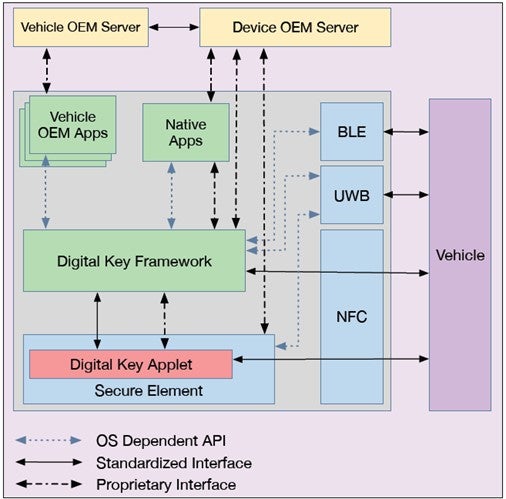Optimizing Automotive Keyless Entry with Bluetooth® Low Energy and LIN
In the automotive industry, the advent of keyless entry system or passive entry passive start (PEPS) system, has revolutionized the way we interact with our vehicles. Keyless entry systems use secure wireless communication to automatically unlock the car and enable the engine to start with a push of a button, without the need to physically handle a key fob. This technology not only adds convenience by simplifying the process of accessing and starting a vehicle but also enhances security through sophisticated authentication procedures that prevent unauthorized access.
The adoption of PEPS in the automotive sector is driven by advancements in wireless technology, such as
Bluetooth ® Low Energy (LE) and encryption standards, which have made them more accessible and affordable. The automotive Bluetooth LE market, including applications such as Bluetooth LE technology-based PEPS, tire pressure monitoring systems (TPMS) and wireless battery management system (WBMS), is expected to grow continuously. The vehicle access market is projected to expand at a steady compound annual growth rate (CAGR) through 2027 (see Figure 1). As these systems become standard in mid-class cars and above, they offer not only improved security against vehicle theft but also a level of integration that simplifies the user experience, making it a key feature in the evolution of vehicle access control.

Figure 1: Automotive Bluetooth LE Market Estimate (Source: Omdia )
Bluetooth LE technology is increasingly adopted in PEPS systems within the automotive industry due to its power efficiency and secure communication capabilities. Bluetooth LE's low power consumption extends the battery life of key fobs and other portable devices, which is crucial for the convenience and reliability of PEPS systems. Additionally, Bluetooth LE supports advanced security features that help prevent relay attacks, ensuring that only authorized users can gain access and start the vehicle.
The Local Interconnect Network (LIN) is a serial network protocol established in the late 1990s by a consortium of European automakers and technology providers. It was designed as a cost-effective, low-speed alternative to more complex systems like the Controller Area Network (CAN) for managing communication between components within vehicles. LIN's architecture allows for a single controller to control up to 15 peripherals[AH5] , making it ideal for managing simple sensors and actuators in modern vehicles. Today, despite the automotive industry's challenges, including production declines, the LIN protocol continues to be integral in vehicle communication systems, with a market that is expected to grow steadily, reflecting its enduring relevance in automotive electronics.
onsemi has developed a reference design that delves into the intricacies of an optimized design for automotive keyless entry systems, utilizing onsemi solutions featuring Bluetooth LE and LIN (Local Interconnect Network) technologies. By integrating these advanced technologies, the proposed design aims to streamline the communication between the vehicle and its keyless entry system, ensuring a seamless and user-friendly experience. The focus is not only on the technical robustness but also on the efficiency and reliability of the system, which are paramount in the automotive sector.

Figure 2: Example of High-Level Car Access Anchor + Sniffer System
This reference design features the automotive−qualified NCV7428 System Basis Chip (SBC) with LIN Transceiver. The internal logic in conjunction with the offered software library can be used to implement LIN 2.x-complaint communication between two programmable devices. We demonstrate the use-case of two peripherals corresponding to the sniffers (PEPS system) and communicating over the LIN bus with the anchor device. The LIN transceiver selected in this design features a 3.3 V internal low-dropout (LDO) voltage regulator that is capable of supplying and protecting loads of up to 70 mA. This allows us to power the RSL10 Evaluation Board directly from the LIN bus and minimize the overall system cost.
onsemi’s automotive portfolio consists of systems-on-a-chip (SoCs) such as NCV-RSL10 (Bluetooth LE 5.0) and the latest automotive NCV-RSL15 (Bluetooth LE 5.2) which provide the industry’s lowest power consumption according to the Ultra−Low Power (ULP) efficiency benchmark EEMBC ULPMark®−CoreProfile score and ULPMARK−CoreMark. These automotive qualified Bluetooth LE SoCs are ideal for car access and WBMS, and are supported by an extensive software development kit with projects and code examples, that enable rapid development of applications with Bluetooth LE.

Figure 3: Bluetooth LE + LIN Anchor/Sniffer Demonstrator Testbench (Left) and Block Diagram (Right), with Test Results in Reference Design (Source: TND6442 )
The following specification is considered the minimum for car access Bluetooth LE device:
• Support of min. Bluetooth LE 5.0
• Ultra-low power consumption
• Up to 10 simultaneous secure connections
• Support of Out-of-Band pairing
• Secure lifecycle management based on Root of Trust (RoT), TrustZone and CryptoCell-312
• AEC-Q100 Grade 2 guarantees up to +105 °C operating temperature.
• Certified cybersecurity implementation
The Car Connectivity Consortium (CCC) standard has significantly influenced the adoption of keyless entry systems by establishing a universal framework for digital keys. This standard allows mobile devices to securely store, authenticate, and share digital keys for vehicles, enhancing convenience and security. The CCC's approach, which includes Near Field Communication (NFC) and Ultra-Wideband (UWB) technologies, has made it easier for consumers to access and start their vehicles using smartphones, thereby accelerating the shift from traditional key fobs to digital solutions.

Figure 4: Functional Block Diagram of CCC Software (Source: CCC)